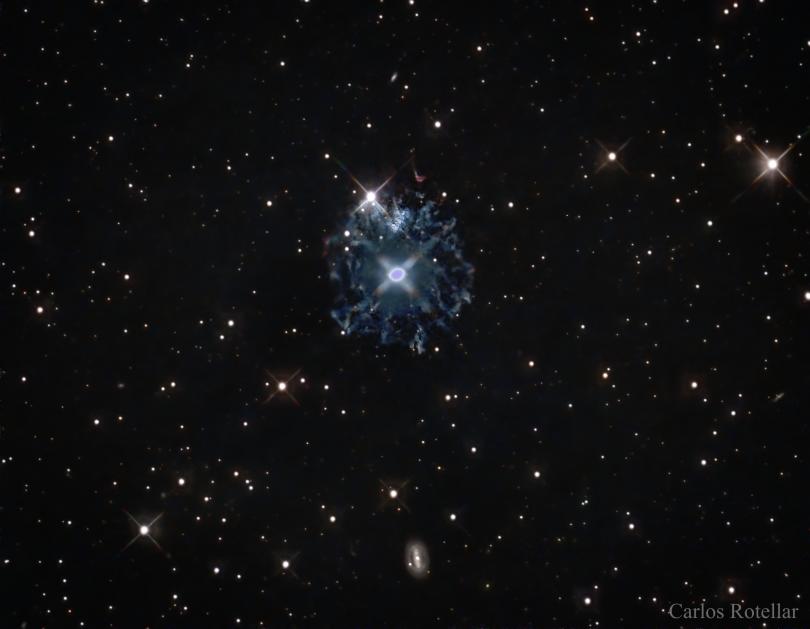
Cat’s Eye Nebula Finder Higher Resolution Image
The Cat’s Eye nebula is the result of a dying star. So-called Planetary Nebulae* are clouds of gas blown off by a dying star. The central stars of most planetary nebulae are mostly inert carbon and oxygen. No further nuclear fusion is possible, and the star simply cools off, radiating away its energy over the next billion years or so.
But the central star in the Cat’s Eye is a ‘wolf’ in sheep’s clothing. The star at the center of the Cat’s Eye has blown off its outer layers, but the core isn’t finished yet. It is still producing heavy elements like magnesium, silicon, and possibly iron at the end. It belongs to a class of stars discovered by Max Wolf and Georges Rayet in 1867.
If the star’s mass is at least 8x the mass of the Sun when it runs out of fuel, it will explode as a Type II supernova. If. The beautiful clouds of glowing gas represent the mass lost by the star. Presently it’s shedding one solar mass every 10 million years. The Sun’s surface temperature is ~6,000 Kelvin. This star’s surface temperature is ten times higher. The ultraviolet radiation both causes the gas to fluoresce and sculpts the outflows into their iconic shapes.
The extended nebula is ~7 light-years in diameter and lies 4500 light-years away in the constellation of Draco.
*Nebula is Latin for “cloud.” The plural is “nebulae.” Planetary nebulae have nothing to do with planets other than suggesting a faded planet in the eyepiece of a telescope.
Photographer’s Notes: Captured in May 2022 with iOptron 8” Ritchey-Chrétien (RC) Telescope and ZWO ASI 2600 Pro color cool camera. Mount used iOptron CEM 40. Integration time 6 hours using 5-minute exposures. Dark, bias and flat frames were used for calibration. Processed in PixInsight and Lightroom. (Photo: Dr. Carlos Rotellar.)
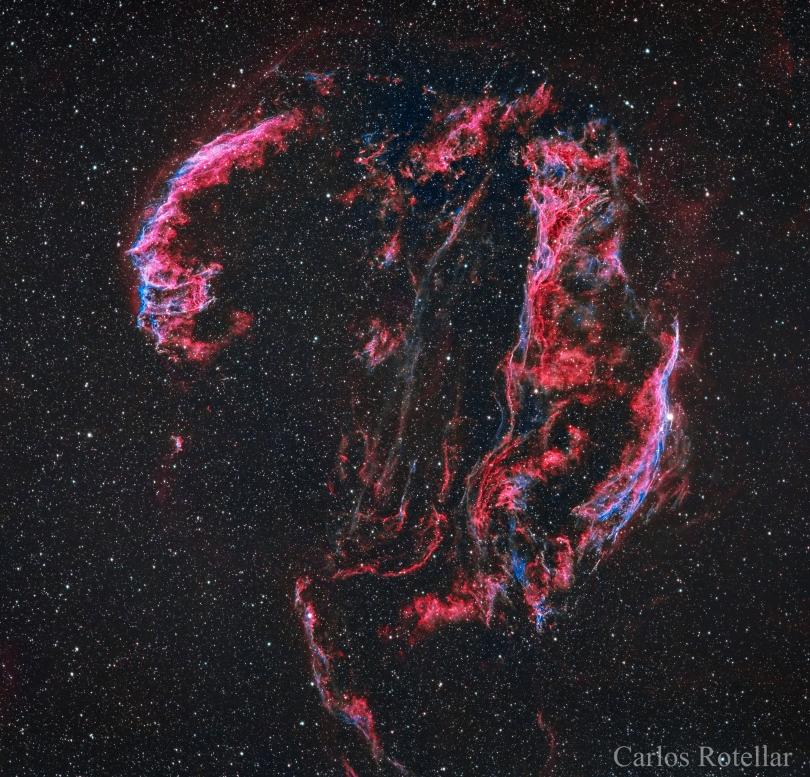
Veil Nebula Finder Higher Resolution Image
The most massive stars are very rare, live life large, and die spectacularly. The Veil is an expanding sphere of gas, the remains of an exploded star. It began life with a mass 20 times the Sun’s. The Sun’s lifetime is 10,000 million years. This star destroyed itself after only 20 million years.
About 8,000 years ago, the light arrived at Earth. It would have shone with the light of a seven-day-old crescent Moon, but with all of the light in a single point in the sky. It would have been visible in daylight and cast shadows at night. It may have been visible for a year or more before fading away. From Lexington, it would have appeared near the zenith during the summer months. Indeed, before the end, the star would have outshone all of the other stars in Cygnus as we see them today.
Initially the gas expanded with a speed of perhaps 10,000 km/s, 3% of the speed of light. Today the gas sweeps through the interstellar medium at a more leisurely 400 km/s. As it collides with the sparse atoms between the stars, they emit visible light, as well as other radiation. The exquisite resolution of the Hubble Telescope allows for the direct imaging of the expansion of the gas.
Photographer’s Notes: The Veil Nebula is classified as a supernova remnant, deriving its name from the intricated and delicate filamentary structures. The entire nebula is 110 light years across and sits 2,100 light years away from earth. It has been divided in three main parts: the Eastern Veil Nebula, the Pickering’s Triangle (in the middle) and the Western Veil Nebula also known as the Witch’s Broom.
Captured in October 2022 with a Williams Optic Zenith 61 mm telescope, ZWO ASI 6200 Pro color cool camera. Integration time 6 hours using 5-minute exposures. Dark, bias and flat frames were used for calibration. Processed in PixInsight and Lightroom. (Photo: Dr. Carlos Rotellar.)

Star Trails Higher Resolution Image
No matter where you are (except at the poles) stars rise in the east and set in the west. Although the length of the day increases over time, this always has been, and always will be, true. Time-lapse photography shows the rotation of the Earth in a way that humans could not otherwise appreciate.
The brightest star near the center of rotation is called Polaris, because it is near the northern rotation axis of the Earth. Astronomers in the northern hemisphere have used this relatively bright marker to align their telescopes since the 18th century. Astronomers in the southern hemisphere must do without, as there are no bright stars near the South Celestial Pole in this era.
The Earth is only an approximation of a sphere. Because it rotates, the Equator bulges outward 43 km (27 mi). Gravitational tugs on the bulge from the Moon and Sun cause the rotation axis of the Earth to sweep out a cone (precess) every ~26,000 years. The best analogy is a spinning top. The pole moves about one degree in a human lifetime (72 years). The Earth will turn on its axis 9 ½ millions times before it returns to its present position to find Polaris waiting for its return.
Almost 2,000 years before the invention of the telescope, the Greek astronomer Hipparchus discovered that the pole was moving. The 26,000 year cycle is illustrated in this Animated Gif (25 MB), PowerPoint (3MB), or PDF (1.5 MB).
Photographer’s Notes: Captured in October 2021 with a Canon 80D Camera. Integration time 2 hours using 30-second exposures. ISO 1600, focal length 50 mm. Processed in PixInsight and Lightroom. (Photo: Dr. Carlos Rotellar.)
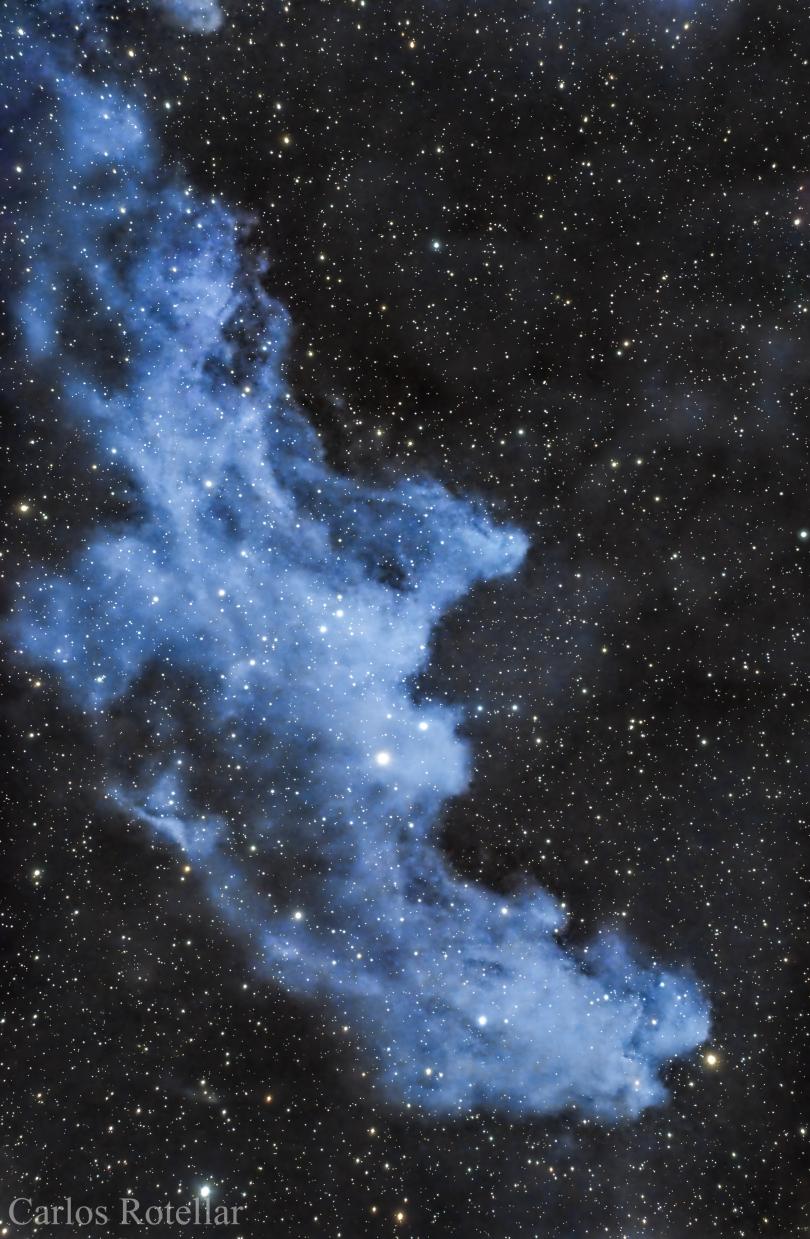
Witch Head Nebula Finder Higher Resolution Image
The space between the stars isn’t completely devoid of matter. Clouds of gas and dust are found if you look carefully. Some are bright enough to be easily seen in a small telescope. Others, like the Witch Head are only visible in long-exposure photographs.
The distinctive blue color of the nebula comes from the color of the star illuminating it, Rigel. Rigel is the brightest star in the constellation Orion, at least until Betelgeuse explodes and temporarily steals the show. Most of the light we see from the Witch Head is reflected by tiny dust grains in the gas. At the putative distance of Rigel, the apparent length of 2⁰ is a true size of 30 light-years “head to chin.”
The human ability to see familiar objects, particularly faces in otherwise randomly arranged features is called pareidolia. Do you see Elvis in this frame from the webcam on the International Space Station?
Six of the seven principal stars in the direction we call “Orion,” are supernova candidates. The are all massive, hot, stellar overachievers and likely will become red giants. Betelgeuse is a red supergiant and is likely the next nearby supernova.
Until 1987, it was thought that all supernovae were exploding red giant stars. But previous imaging of the Supernova 1987A progenitor showed it to be a blue giant star. Sometimes blue giants can also explode: attentus perpetuum.
Photographer’s Notes: Captured in December 2021 with Orion ED80T CF Triplet Apochromatic Refractor Telescope and ZWO ASI 294 Pro color camera. Mount used iOptron EQ30 Pro. Integration time 4 hours and 28 minutes using 4-minute exposures. Dark, bias and flat frames were used for calibration. Processed in PixInsight and Lightroom. (Photo: Dr. Carlos Rotellar.)
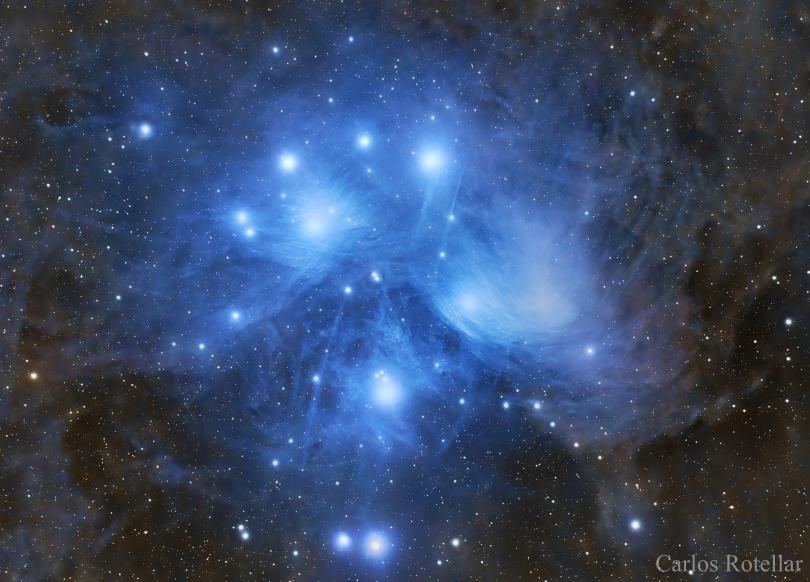
The Pleiades Star Cluster Finder Higher Resolution Image
Stellar clusters exist because the stars were formed together out of the same gas and dust at the same time. Therefore, we expect stars in a cluster to be the same age. The third nearest star cluster to Earth is the Pleiades cluster (450 light-years). (The nearest is the Hyades Cluster.) Easily visible in winter months, they have been a traditional test of the sensitivity of a person’s eyesight. How many can you see?
Since the stars of the Pleiades are all at about the same distance, any differences in the brightness of a star is real. The most easily observed stars, really are brighter. A star like the Sun placed in the cluster would require a small telescope to observe.
The cluster is close enough to measure their apparent motions across the sky. In this diagram, the stars of the Pleiades are plotted with their apparent motions over the next two millennia. The stars with discordant motions are likely not actual cluster members, but chance alignments. Another indicator are their distances from Earth. We expect the cluster stars to be at more or less the same distance.
The wispy dust cloud seen throughout the cluster is a happenstance. The cluster just happens to be moving through it. The blue color is from the hot, blue stars of the cluster reflected by dust grains. The dust particles themselves are aligned along local galactic magnetic fields.
In Greek mythology the Pleiades are associated with the daughters of Atlas, who also claims one of the stars as his namesake.
Photographer’s Notes: Captured in October 2021 with Orion ED80T CF Triplet Apochromatic Refractor Telescope and ZWO ASI 6200 Pro color cool camera. Mount used iOptron EQ30 Pro. Integration time 3 hours and 35 minutes using 5-minute exposures. Dark, bias and flat frames were used for calibration. Processed in PixInsight and Lightroom. (Photo: Dr. Carlos Rotellar.)

The Andromeda Galaxy (Messier 31) Finder Higher Resolution Image
Often cited as the farthest thing a human can see without optical aid, it is about 2 ½ million light-years away. It can be seen from a dark site if you know where and when to look. Where is linked in the title. When, are dark nights Fall through Spring in the northern hemisphere. Don’t look for spiral arms. Most of the light in spiral galaxies come from its core. Digital photography allows the much dimmer spiral arms to be shown side-by-side with the core. The true shape of Andromeda is a very thin disk with a bulge of much older stars in the center. At a distance of 2.5 million light-years, the light we see today left Andromeda as homo habilis entered our fossil record.
Drawing a profile through the center of this galaxy (MSO image) out through the spiral arms, and plotting the brightness, judiciously missing any bright stars from our galaxy, shows how the light is completely dominated by the core. This is typical of spiral galaxies.
There are two spheroidal, fuzzy objects, one to left of center and one to the lower right. These are dwarf galaxies. The Milky Way has about 20 known dwarf companions. These are just two of Andromeda’s brightest and are visible in a backyard telescope. As they orbit around its parent galaxy, gravitational tugs from repeated passes through the plane of Andromeda may eventually tear them apart. Indeed, they may already be shadows of their former selves.
The dark lanes are caused by intervening dust in its galactic plane. This tells us that the lower part of the image is the side closest to us. The galactic disk is tipped to our line-of-sight by about 30⁰. Since we see Andromeda at about the same angular distance from our own galactic plane, by an odd coincidence, Andromedean astronomers looking back in our direction will see substantially the same thing. Be sure to wave.
Photographer’s Notes: Captured in December 2023 with Orion ED80T CF Triplet Apochromatic Refractor Telescope and ZWO ASI 6200 Pro color cool camera. Mount used iOptron EQ30 Pro. Integration time 12 hours using 5-minute exposures. Dark, bias and flat frames were used for calibration. Processed in PixInsight and Lightroom. (Photo: Dr. Carlos Rotellar.)
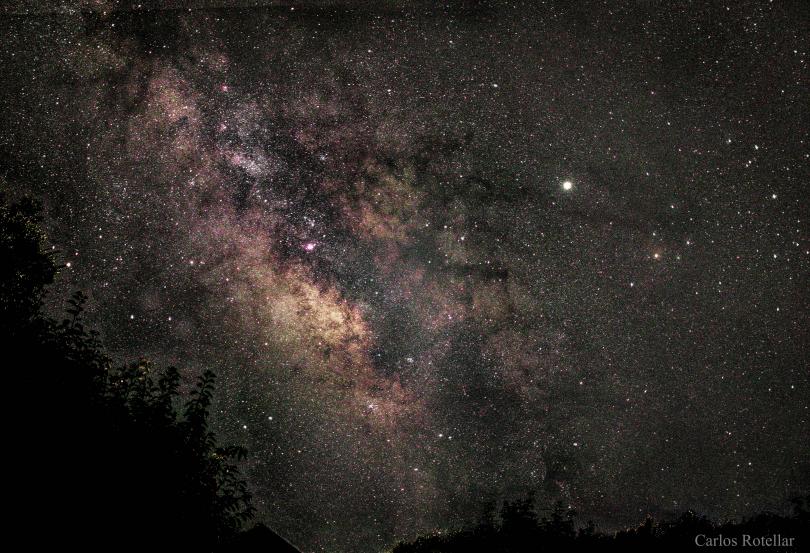
The Milky Way Finder Higher Resolution Image
Our home galaxy, the Milky Way, is shaped very much like our nearest large companion, Andromeda: a thin disk that bulges in the middle. Since we live in the disk about 2/3rds of the way from the center, the Milky Way seems to surround us, which it does. At a distance of about 26,000 light years, the light left the core before humans learned to plant crops. Alternatively, it was about the last time Polaris was near the celestial pole.
The Galactic Center is in the direction we call Sagittarius. In long exposure photographs, the Galactic bulge is apparent, sticking out beyond the intervening dust lanes. The center itself, is impossible to see in visible light. Only one photon in a million-million gets through the dust cluttering the disk.
At the center, there is a Super Massive Black Hole (SMBH) with a mass four million times the Sun’s. By using unprecedented observing techniques, linking radio telescopes all over the world, our SMBH was imaged first in 2022.
For this, the Nobel Prize in Physics (2020) was awarded for the “for the discovery of a supermassive compact object at the center of our galaxy.” The evidence for the black hole and its mass has been evident for some time. We move through space, following the path afforded us by the Sun’s gravity. Likewise, stars at the Galactic Center move around our SMBH because of its gravity. The first radio image of our SMBH was released in 2022.
It is from these observations that the mass of our SMBH was determined to be four million solar masses. It took astronomers about 100 years to achieve this level of understanding of our home.
Photographer’s Notes: Captured in July 2019 with Canon 80D Camera. Integration time 1 hour using 10-second exposures. ISO 3200, focal length 24 mm. (Photo: Dr. Carlos Rotellar.)
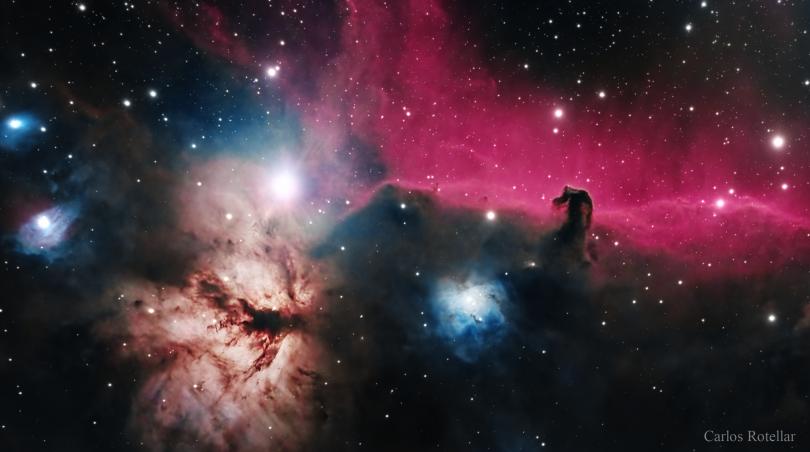
The Horse Head Nebula Finder Higher Resolution Image
Humans have the tendency to see familiar objects in otherwise random light and shadows. Still, it’s really hard for anyone to look at the Horsehead without thinking racetrack, unless you’ve never seen a horse. Or maybe a Zebra. The Horsehead is a difficult object to observe visually without an extremely dark site and a large telescope. It’s no surprise that it was discovered photographically by one of the famous Harvard “computers,” Williamina Fleming in 1888. It were images taken by E. E. Barnard that eventually persuaded astronomers that dark areas in the sky were not special places devoid of stars, but instead intervening opaque material.
Colors are very important in astronomy. The deep red in images taken at visible wavelengths, usually represents ionized hydrogen, the most common element in the universe. In the case of the glowing cloud at the left and center, clouds of gas and dust have begun to collapse and form new stars. The direction of Orion is awash in ionized hydrogen.
New stars are hot and emit energetic photons that temporarily remove the single electron in a hydrogen atom. (It isn’t difficult. You could do it with the potential of a car battery.) When an electron eventually finds a lone proton and recombines to make a complete hydrogen atom, one of the colors it emits is a specific color of red. It isn’t very different from the color from a red laser pointer.
Spiral galaxies are still creating stars from their leftover gas and dust. A galaxy with a red splotch generally means new stars are being formed.
Photographer’s Notes: Captured in February 2021 with Orion ED80T CF Triplet Apochromatic Refractor Telescope and ZWO ASI 294 Pro color camera. Mount used iOptron EQ30 Pro. Integration time 4 hours and 56 minutes using 5-minute exposures. Dark, bias and flat frames were used for calibration. Processed in PixInsight and Lightroom. (Photo: Dr. Carlos Rotellar.)
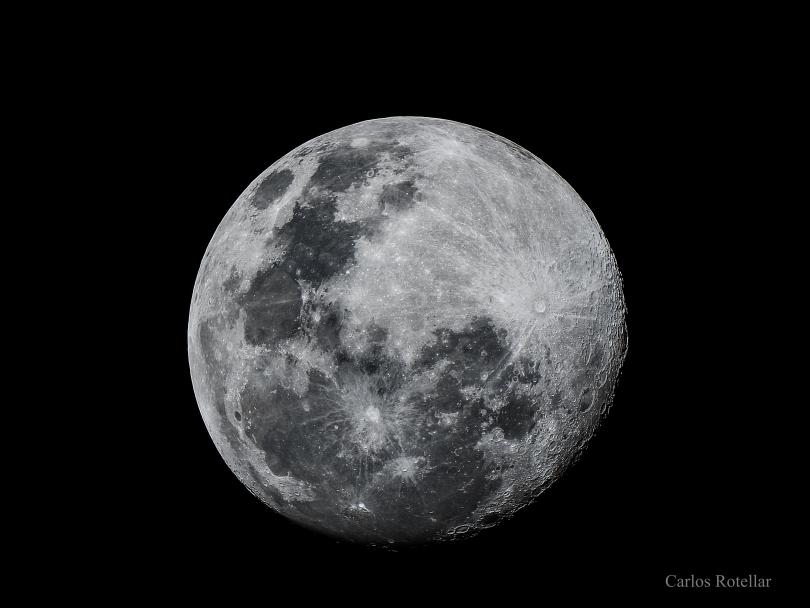
Earth’s Moon Higher Resolution Image
Earth’s nearest neighbor, it is only one of three moons located within the inner solar system, and the only inner solar system moon that was formed in place. Martian moons were likely captured objects from the asteroid belt. Earth’s surface ages with time. There are very few Earth rocks left over from its formation. Having formed with the Earth, our moon is a lab for determining the age of the Earth, if rock samples could be obtained. Between 1969 and 1972, Apollo astronauts returned 838 # (381 kg) of rocks to Earth.
When Galileo looked at our moon through his state-of-the-art telescope in 1609, he saw craters (cups) and maria (seas). The Apollo results revealed that the heavily cratered areas (highlands) are 4.5 billion years old, and the smoother regions (maria) a billion years younger. And how convenient that the moon is only a quarter of a million miles away, instead of say, a moon around another planet.
The moon’s orbit is tipped about 5.5⁰ to the Earth’s. From Earth the moon is always seen within 5.5⁰ of the apparent path of the Sun (the Ecliptic). From time to time, the Moon will eclipse bright stars and clusters, including Regulus, the Pleiades, and planets.
NASA’s Lunar Reconnaissance Orbiter was launched in 2009 and is still sending very high resolution imaging and altimetric data from the moon. Your exploration of the lunar nearside begins here.
Photographer’s Notes: Captured in October 2021 with Williams Optic Zenith 61 mm telescope, ZWO ASI 2600 Pro color cool camera. Using SharpCap software I obtained 5 minutes of video. Video processed with PIPP to obtain best 1,200 frames that were stacked and further processed with RegiStax. Final touches done in PixInsight and Lightroom. (Photo Dr. Carlos Rotellar.)

The Orion Nebula Finder - Messier 42 Higher Resolution Image
From any reasonably dark site, M42 is visible to the naked eye as a hazy patch of light south of Orion’s belt stars. Galileo almost certainly saw it in his telescope, but failed to mention it, likely because he couldn’t explain it. William Herschel had a running disagreement about the nature of celestial nebulae. Initially he argued that the light came from many unresolved stars. Eventually he wrote he thought they were clouds of shining fluid, which is the correct interpretation.
This is the nearest star-forming region to Earth, about 1350 light-years away, the visible area is about 25 light-years across. The gas fluoresces because of new (and very short lived) stars forming near the center. Most of the ionizing radiation comes from a single star, Theta-1c Orionis. The radiation from these stars is hollowing out their neighborhood, dispersing the gas from the region. It is one of the most studied regions in the sky, including researches done here at the University of Kentucky. Combining ground based data with that from the Hubble Space Telescope it is possible to create a “fly-through” of the nebula. The tadpole shaped objects are nascent stars still in their gaseous cocoons. They all point away from the Theta Orionis stars the way a flag points away from the direction of the wind.
Photographer’s Notes: Captured in March 2021with Orion ED80T CF Triplet Apochromatic Refractor Telescope and ZWO ASI 294 Pro color camera. Mount used iOptron EQ30 Pro. Integration time 2 hours and 40 minutes using 5-minute exposures. Dark, bias and flat frames were used for calibration. PixInsight and Lightroom. (Photo: Dr. Carlos Rotellar.)
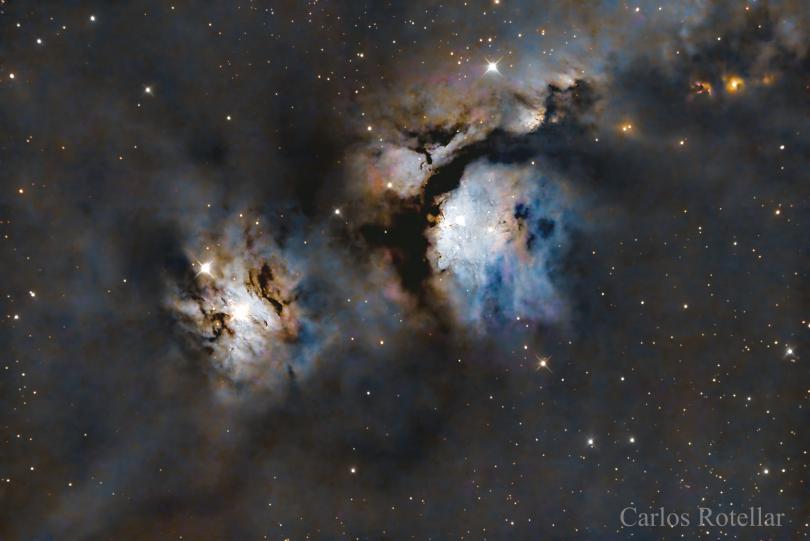
Messier 78 Finder Higher Resolution Image
Charles Messier was a French astronomer working in Paris at about the time of the American revolution. His telescope was modest, even for the times. He main interests were in finding comets. This is understandable since the night sky is a relatively static thing. Comets do all sorts of interesting things. They move. They sometimes break apart, and occasionally go too near the Sun and completely evaporate.
While searching for comets from the rooftop of the Hotel de Cluny, he (and colleagues) kept finding fuzzy things that were reminiscent of comets, but didn’t appear to move. Messier was a bit put-out by having to see if the object moved the next night, which took away valuable comet hunting time. So he made a catalog of his non-comets and published it as a catalog to save astronomers the time in chasing undomesticated ornithoids.
It would have never crossed his mind that his catalog of throw-aways were to become a backbone of astronomy. What he cataloged were the brightest star clusters, nebulae, and galaxies visible in the northern hemisphere.
The 78th entry in his catalog is another star-forming region. These are very young stars. The cluster apparently lacks the massive stars of the Orion Nebula. About 1400 light-years away it is about 10 light-years in diameter.
Photographer’s Notes: Captured in February 2022 with iOptron 8” Ritchey-Chrétien (RC) Telescope and ZWO ASI 2600 Pro color cool camera. Mount used iOptron CEM 40. Integration time 2 hours and 45 minutes using 5-minute exposures. Dark, bias and flat frames were used for calibration. Processed in PixInsight and Lightroom. (Photo: Dr. Carlos Rotellar.)
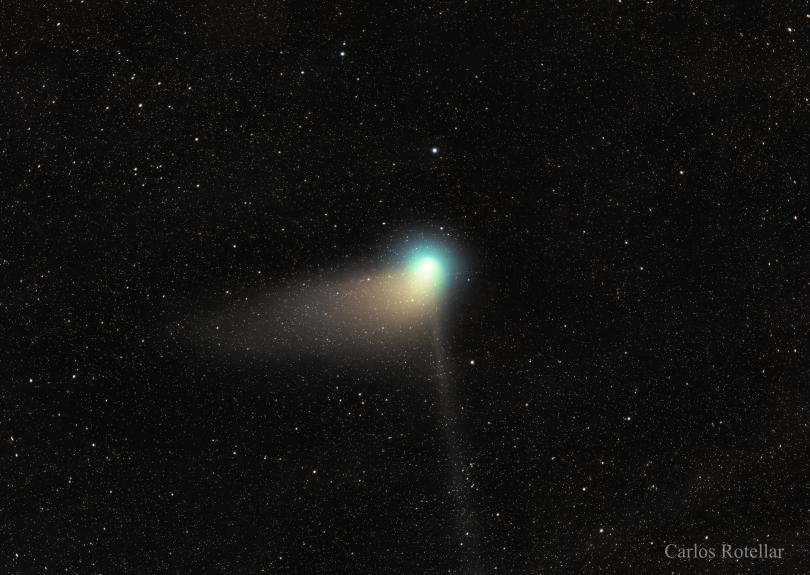
Comet 2022 E3 Finder on February 3, 2023 Higher Resolution Image
Comets are the solar system’s windsocks: their tails point away from the Sun. When you put a dirty snowball near the fireplace, it evaporates. When a comet gets closer to the Sun than the orbit of Jupiter, its icy surface begins to sublimate, liberating any imbedded dust. Now the comet has two tails: one of gas and one of dust. The path of the tail material is determined by the motion of the comet and the outflow of gas from the Sun called the Solar Wind. The gas tail always points in the direction of the solar wind. The dust tail is made of larger particles, and is less affected by the solar wind.
The image was captured on February 3, 2023 while the comet was located in the direction of Camelopardalis. Three features stand out;
Photographer’s Notes: The comet is a stacked photo of 17 images of 5 minutes each taken with a 61 mm Williams Optics telescope and with the ZWO ASI 6200 cooled camera and processed with PixInsight and Adobe Lightroom. (Photo: Dr. Carlos Rotellar.)
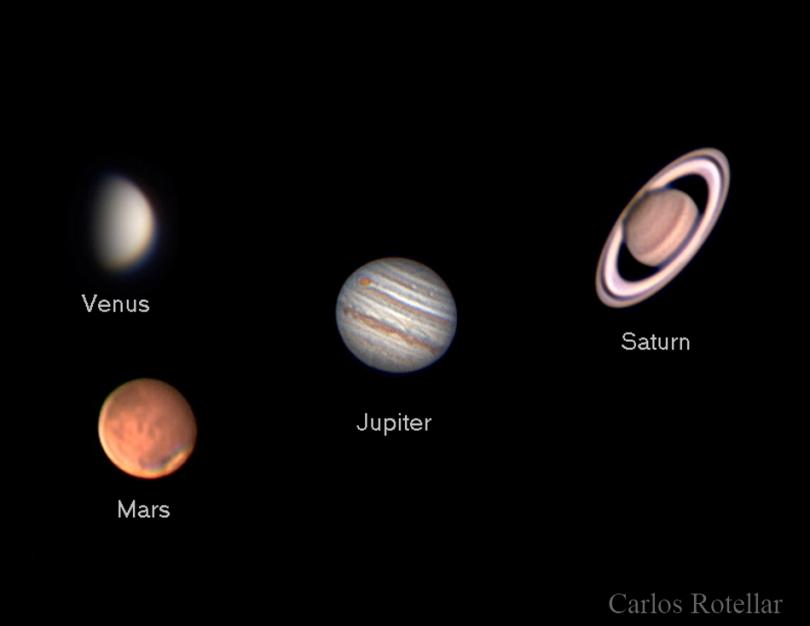
Four Planets Higher Resolution Image
Astronomers have come to an agreement that there are eight major planets in the solar system. They can be roughly divided into two categories: rocks and gas giants. Mercury, Venus, Earth, and Mars are essentially rocks. Jupiter, Saturn, Uranus, and Neptune are massive balls of gas.
Jupiter dominates the planetary mass of the solar system. Jupiter’s fraction of the total planetary mass is 71%. However, the total planetary mass compared to the Sun is 0.13 %. Planets appear to be something of a stellar system afterthought.
NASA/SWRI are operating (2023) the Juno probe in orbit around Jupiter. The JunoCam images are open to the public. Processing them into beautiful works of art has become a favorite activity for astronomy enthusiasts.
All of the gas giants have a system of rings. Only Saturn’s are obvious from Earth. Astronomers are still arguing about their age. Are they relatively young and transient? Or are they ancient and therefore a permanent feature?
Photographer’s Notes: Captured in June, 2018 with a Celestron 5” Schmidt-Cassegrain (SCT) telescope and ZWO ASI 224 planetary camera. Using SharpCap software I obtained 5 minutes of video. Video processed with PIPP to obtain best 1,200 frames that were stacked and further process with RegiStax. Final touches done in PixInsight and Adobe Lightroom. (Photo: Dr. Carlos Rotellar.)
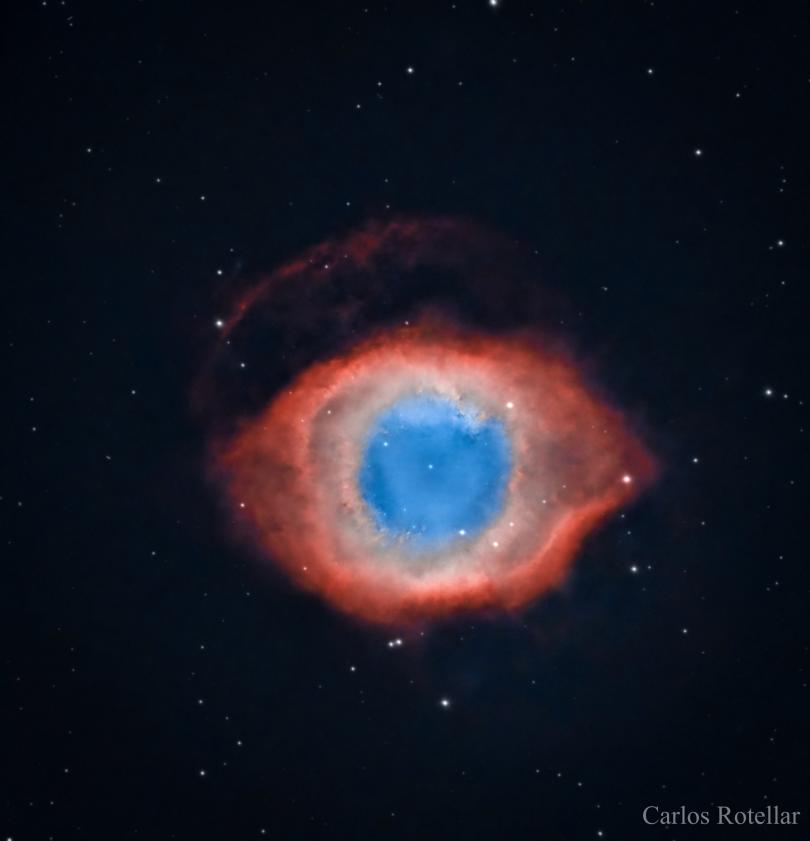
The Helix Nebula Finder Higher Resolution Image
The Helix Nebula (NGC 7293) is another example of a so-called Planetary Nebula. About 650 light-years away, the brightest parts are 3 light-years in diameter. Planetary Nebulae are very short-lived, in astronomical timescales, perhaps 50,000-100,000 years. The expelled gas from the central star will continue to expand, seeding material rich in carbon and oxygen into the into the space between the stars. Oxygen is important for forming planets like the Earth: about half of the Earth’s mass is oxygen and oxygen is the most common element in the Earth. (Most of the oxygen is combined in various ways with silicon in the Earth’s mantle.)
The central star in the Helix lacks the mass to explode at the end of its life (which is nigh). When it can no longer create new elements to generate energy, it will shrink to an object that is about the diameter of the Earth but has a mass similar to the Sun’s. These are called White Dwarfs and it is the fate of all Sun-like stars. As an example, a WD with the mass of the Sun and the diameter of the Earth, would have a density ~8 million times that of water. The population of WD’s in the Milky Way is ~10 billion. By themselves, they are too small to be seen easily from any great distance.
Photographer’s Notes: Captured in October, 2022 with iOptron 8” Ritchey-Chrétien (RC) Telescope and ZWO ASI 6200 Pro color cool camera. Mount used iOptron CEM 40. Integration time 2 hours using 5-minute exposures. Dark, bias and flat frames were used for calibration. Processed in PixInsight and Lightroom. (Photo: Dr. Carlos Rotellar.)
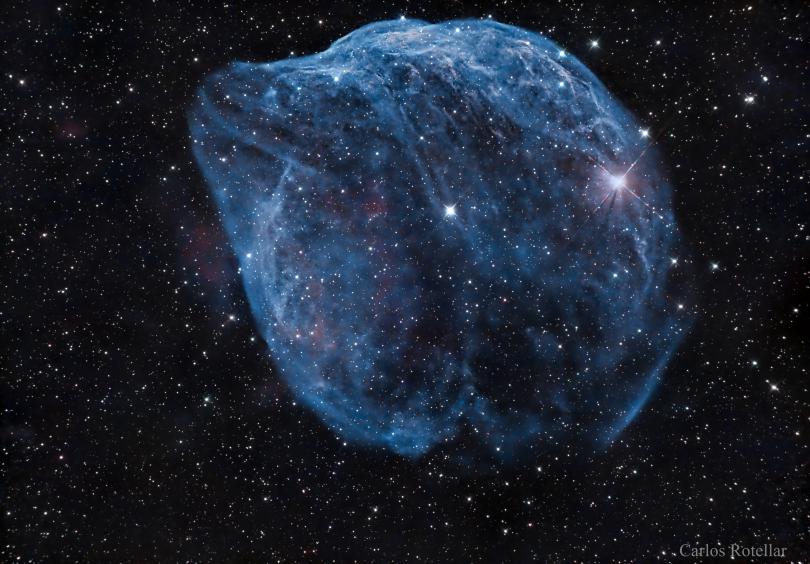
Dolphin Head Nebula - Sharpless-308 Finder Higher Resolution Image
The Dolphin Head Nebula (Sharpless-308) is classified as an HII region. This is the astronomer’s way to note that the atom emitting the light is hydrogen with its only electron missing. When the lone proton recombines with an electron, it emits a bunch of colors, but most strongly a single shade of red. The Dolphin appears more blue in the camera because there is also quite a bit of doubly ionized oxygen (OIII) in the gas, which emits a distinctive green.
The Dolphin never gets higher than 30⁰ above the horizon from Lexington, so it isn’t that easy to image. At 30⁰ the nebula is behind twice as much atmosphere than it would be if it were directly overhead.
The distance to the central star is known to be 5,000 light-years distant using data from the GAIA satellite.
With an apparent diameter slightly larger than Earth’s moon, it is 50 light-years in diameter. The central star EZ Canis Majoris is known to be a Wolf-Rayet star that will eventually explode. That almost certainly will not happen in our lifetimes. However, when it does it will be certainly brighter than Sirius, which is currently the brightest star in our night sky.
Photographer’s Notes: Captured in January 2023 with iOptron 8” Ritchey-Chrétien (RC) Telescope and ZWO ASI 6200 Pro color cool camera. Mount used iOptron CEM 40. Integration time 2 hours and 15 minutes using 5-minute exposures. Dark, bias and flat frames were used for calibration. Processed in PixInsight and Lightroom. (Photo: Dr. Carlos Rotellar.)

Messier 13 Globular Cluster in Hercules Finder Higher Resolution Image
M13 is not just a cluster of stars, it is a Globular Cluster. These are different from ordinary, galactic clusters. They have far more stars and are much older. M 13’s star number some 500,000. Globulars are also relatively rare: there are only about 200 associated with the Milky Way. Globulars in our galaxy are as old as the Milky Way itself.
The colors in Dr. Rotellar’s image tell us much about stellar evolution. The hottest stars are blue, the coolest stars are orange and red. This interactive simulation from the University of Colorado will illustrate the essentials.
Globulars are very crowded places. Isaac Asimov speculated that it might not be immediately obvious to astronomers within a globular cluster that there was a greater universe beyond if the sky was awash in brilliant stars.
In 1974, as a publicity event, Dr. Frank Drake used the largest radio telescope in the world to broadcast a brief message in the direction of M13. At a distance of ~23,000 light years, it will be ~50,000 years for any reply. The message is an example of the adage that a picture is worth a thousand words. With 1,679 bits an enormous amount of information is conveyed by arranging the 1’s and 0’s into a crude image. If there is a reply, the Arecibo telescope will not be on the receiving end.
Photographer’s Notes: Captured in March 2021 with Orion 6” Ritchey- Chretien (RC) Telescope and ZWO ASI 294 Pro color camera. Mount used iOptron CEM 40. Integration time 36 minutes using 4-minute exposures. Dark, bias and flat frames were used for calibration. Processed in PixInsight and Lightroom. (Photo: Dr. Carlos Rotellar.)
Dr Rotellar obtained his medical degree from the University of Barcelona, Spain. After becoming a nephrologist, he spent a year in both London, England and Paris, France to further specialize. He then completed a Nephrology fellowship at Georgetown University Medical Center in Washington DC. He joined the Georgetown faculty for seven years before moving to Bowling Green, Ky to practice nephrology.
He became interested in astrophotography after the total solar eclipse in 2017. Since then, he has been taking images of the sky from his driveway.

